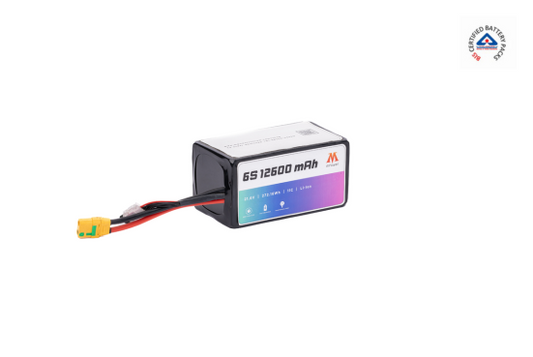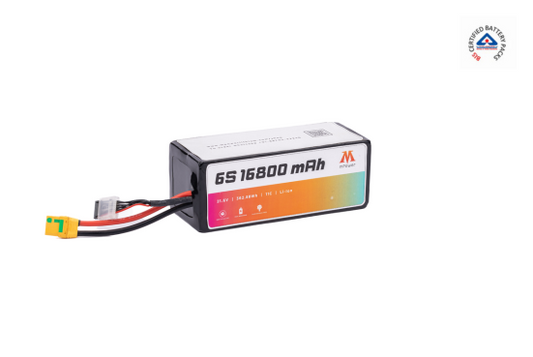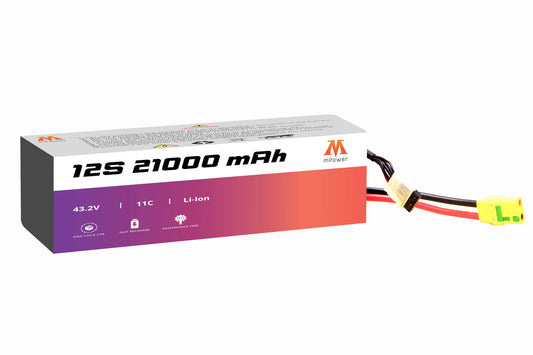
Drones have revolutionized industries, from photography and agriculture to delivery services and security. At the heart of every drone is its battery, providing the energy to keep these devices flying. One of the main concerns for drone enthusiasts and professionals alike is maximizing battery performance. Proper care of a drone's battery not only extends flight time but also enhances the longevity of the battery itself, reducing costs over time. In this guide by mPower, we’ll cover the best practices for optimizing drone battery performance and answer common questions, such as "How many hours should drone battery charge?".
What are the Types of Drone Batteries?
Most drones use either Li-Po (Lithium Polymer) or Li-Ion (Lithium-Ion) batteries. Li-Po batteries are traditional batteries with high energy density and lightweight nature, making them ideal for aerial applications. However, they require specific care to maintain optimal performance. On the other hand, Li-Ion batteries are based on the latest technology, are durable, and charge faster and lighter than LiPo equivalents
Regardless of the type of battery your drone uses, certain universal practices can extend their lifespan and improve performance.
How Many Hours Should Drone Battery Charge?
This is one of the most frequently asked questions by drone users. The charging time of a drone battery depends on its capacity, typically measured in milliamp-hours (mAh). For instance, a 5,000mAh battery may take between 60 to 90 minutes to charge fully, while larger capacities can take longer.
As a general rule, it’s critical to avoid overcharging the battery. Even though most modern drones come with smart chargers that automatically stop charging once the battery is full, it’s good practice to monitor the process. A common recommendation is to unplug the battery as soon as it reaches 100%, especially if your charger doesn’t have an automatic shutoff feature.
What Is the Optimal Way to Manage Drone Battery Charge Cycles?
One of the most common mistakes made by drone users is not paying attention to the battery's charge and discharge cycles. Every drone battery has a finite number of charge cycles, usually between 300 and 500. A cycle refers to the process of fully charging the battery and then discharging it during flight. By not fully discharging the battery each time, you can extend its total number of cycles.
Moreover, it’s essential never to let the battery drain completely. Many experts recommend keeping the charge level above 20% to avoid damaging the battery cells.
Optimal Charging Practices
Here are some tips to ensure that your charging habits align with extending the life of your drone battery:
- Avoid Fast Charging: While it may be tempting to use fast chargers to reduce charging time, this can cause the battery to overheat, leading to permanent damage over time.
- Use Manufacturer-Recommended Chargers: Always use chargers that are designed specifically for your drone model. Generic chargers may not deliver the correct voltage, causing inefficiency and potential harm to the battery.
- Charge in a Cool Environment: Extreme temperatures, especially heat, can degrade battery performance. It’s best to charge your battery in a cool, dry area away from direct sunlight.
- Storage Charging:If you’re not planning to use your drone for an extended period, store the battery at around 50-60% charge. Storing a fully charged or completely drained battery for long periods can shorten its lifespan.
For more details, check our blog post, “What Charging Habits Can Improve Your Drone Battery Efficiency?”
Maintain Optimal Flight Conditions
While flying a drone, the conditions you expose it to impact battery performance directly. Here’s how to ensure your battery operates efficiently during flight:
Avoid Extreme Temperatures:
Both very hot and very cold environments can significantly reduce battery efficiency. In colder weather, battery cells may struggle to deliver power, reducing flight time.
Avoid Aggressive Maneuvers:
Fast ascents, sharp turns, or abrupt descents can cause the motors to draw more power, draining the battery faster. Try to maintain smooth and steady flight patterns to prolong battery life during each flight.
Keep the Drone Light:
The heavier the drone, the more power it requires to stay in the air. Remove any unnecessary attachments or payloads to optimize battery efficiency.
Conclusion
Maximizing your drone’s battery performance requires attention to both charging and usage habits. By understanding how to charge, store, and maintain your battery properly, you can not only extend its life but also ensure safer and more reliable flights. Whether you’re using a drone from a leading brand like mPower or another model, these best practices will help you get the most out of your device’s battery. Remember, questions like "How many hours should drone battery charge?" should always be answered by consulting your drone’s specific manual, but the general rule of thumb is to avoid overcharging and monitor the process closely.
By following these strategies, you’ll enjoy longer flight times, safer operation, and fewer costly replacements, ensuring that your drone remains in top condition for all your aerial adventures.
Click here to order drone batteries from mPower.












